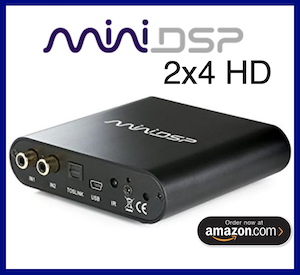LeaUK
Registered
Thread Starter
- Joined
- Nov 1, 2018
- Posts
- 14
Hi All
New to REW so please forgive me for a while ;-)
So this weekend I created the REW impedance measuring jig including a 0.1% 100R resistor to be used with my two channel Focusrite Scarlett 2i2 (headphone out) and it was a reasonable success, however I have a couple of questions/observations where maybe I'm doing something wrong? I followed the REW guide on impedance measurement and calibration for both shorted measurement 100R and shorted RLeads (croc clips at load). See here for my setup: https://1drv.ms/u/s!AgmKo7c0CB2xjS235af9K7K34W89
The 100R resistor is close to the Scarlett and you'll see croc clips used to short the 100R for cal purposes - this I found to be a must. The croc clips at the end of the lead are for speaker connection. The cables used aren't the best quality (Chinese imports) however I noted the cal process so this would hopefully compensate. I performed repeated tests to provide confidence in the cable and clips construction and all joints throughout were soldered.
Observations:
1. Fiddly - Using the Scarlett (which has two input gain potentiometers), I found it tricky to align both input channels to within 2%, I got there by using the Generator and Levels controls by eye, then switching to impedance measurement mode and running the 100R short cal process (RSense = 0) - some further slight adjustment was needed at this too, tiny movements required.
2. After carrying out the above rig calibration, I noticed the headroom may also need adjusting depending on load R, my test sample was a 0.1% 100R resistor, so maybe a little too large for real world, but it's the only one I can depend on the accuracy for (don't have a 4 wire resistance meter to hand). Don' touch the input pots, simply increase/decrease the headphone out volume.
3. For each speaker measurement it seems to make sense to calibrate both, leads and rig, before hitting go, as any variation of the input pots coupled with internal Scarlett variations (due to temperature/voltage regulation) could seriously affect results.
4. Accuracy - so RLead short gave 766mR, sounds perfectly sensible considering the quality and length of the test leads, I double checked by shorting the leads close to the 100R measurement R and this yielded 0R, so can confidently assume 766mR is good for my leads.
This was entered into the RLeads field.
However - my 0.1% 100R test resistor measured at 99.3R.
So, as i can't measure the exact R for both the measurement R and the R undertest, we could assume worst case of both resistors being 0.1% (0.1R) yielding 0.2% error, however that only allows for 0.2R i.e. a measurement worst case at 99.8R
.
Of course that's probably too simplistic so I'll check the math...
I'm wondering if the accuracy increases with lower R AND for real world impedance plots, do we really care if the measurement is out by a fraction of an R?
Any thoughts most appreciated.
Cheers
Lea
New to REW so please forgive me for a while ;-)
So this weekend I created the REW impedance measuring jig including a 0.1% 100R resistor to be used with my two channel Focusrite Scarlett 2i2 (headphone out) and it was a reasonable success, however I have a couple of questions/observations where maybe I'm doing something wrong? I followed the REW guide on impedance measurement and calibration for both shorted measurement 100R and shorted RLeads (croc clips at load). See here for my setup: https://1drv.ms/u/s!AgmKo7c0CB2xjS235af9K7K34W89
The 100R resistor is close to the Scarlett and you'll see croc clips used to short the 100R for cal purposes - this I found to be a must. The croc clips at the end of the lead are for speaker connection. The cables used aren't the best quality (Chinese imports) however I noted the cal process so this would hopefully compensate. I performed repeated tests to provide confidence in the cable and clips construction and all joints throughout were soldered.
Observations:
1. Fiddly - Using the Scarlett (which has two input gain potentiometers), I found it tricky to align both input channels to within 2%, I got there by using the Generator and Levels controls by eye, then switching to impedance measurement mode and running the 100R short cal process (RSense = 0) - some further slight adjustment was needed at this too, tiny movements required.
2. After carrying out the above rig calibration, I noticed the headroom may also need adjusting depending on load R, my test sample was a 0.1% 100R resistor, so maybe a little too large for real world, but it's the only one I can depend on the accuracy for (don't have a 4 wire resistance meter to hand). Don' touch the input pots, simply increase/decrease the headphone out volume.
3. For each speaker measurement it seems to make sense to calibrate both, leads and rig, before hitting go, as any variation of the input pots coupled with internal Scarlett variations (due to temperature/voltage regulation) could seriously affect results.
4. Accuracy - so RLead short gave 766mR, sounds perfectly sensible considering the quality and length of the test leads, I double checked by shorting the leads close to the 100R measurement R and this yielded 0R, so can confidently assume 766mR is good for my leads.
This was entered into the RLeads field.
However - my 0.1% 100R test resistor measured at 99.3R.
So, as i can't measure the exact R for both the measurement R and the R undertest, we could assume worst case of both resistors being 0.1% (0.1R) yielding 0.2% error, however that only allows for 0.2R i.e. a measurement worst case at 99.8R
.
Of course that's probably too simplistic so I'll check the math...
I'm wondering if the accuracy increases with lower R AND for real world impedance plots, do we really care if the measurement is out by a fraction of an R?
Any thoughts most appreciated.
Cheers
Lea
Last edited:












